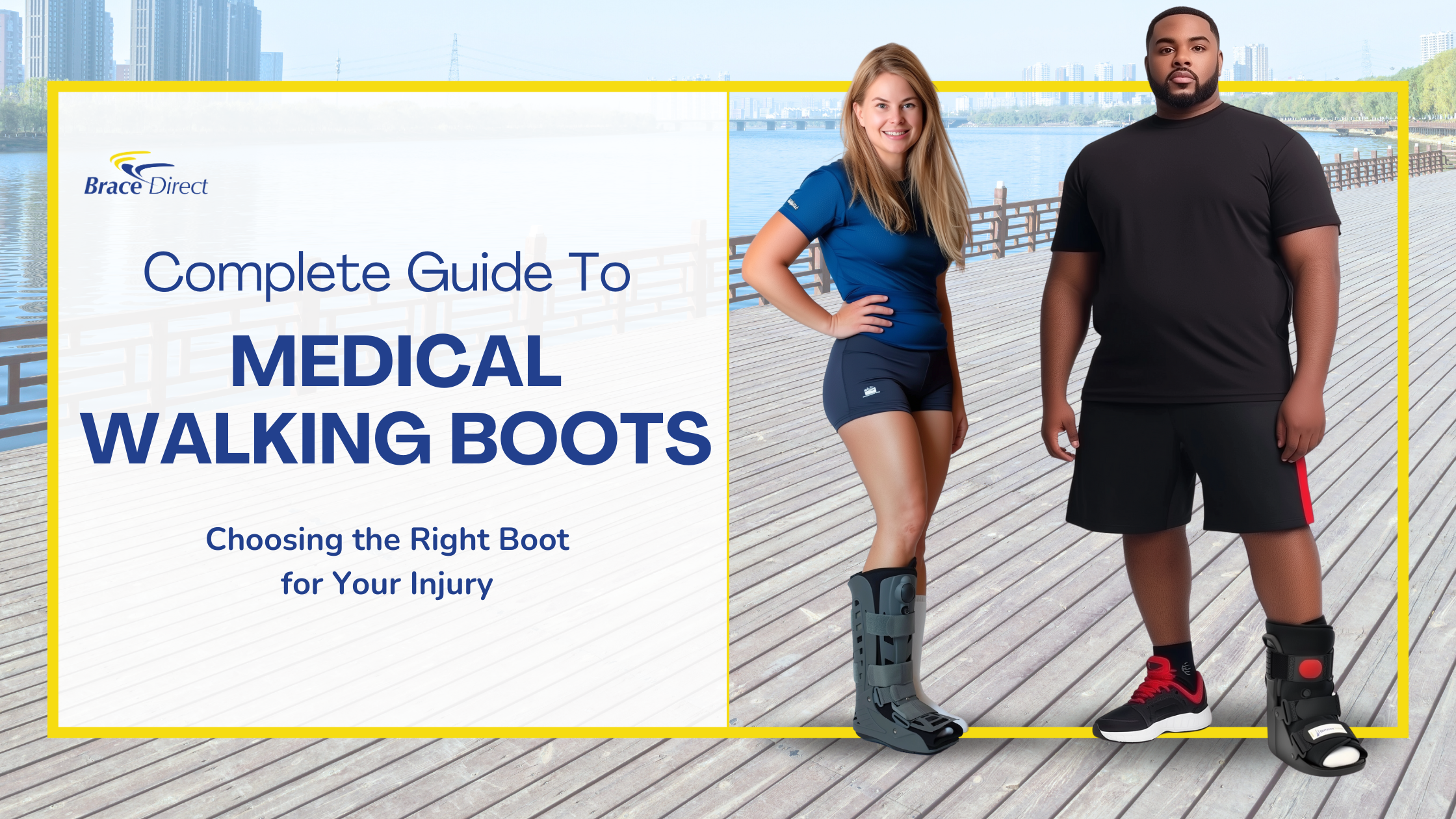9am - 5pm EST M-F
9am - 5pm EST M-F

Medical walking boots help protect injured feet and ankles during healing. If your doctor has recommended a walking boot, you might wonder which type is best for your injury. With several options available, picking the right boot matters for proper healing and comfort.
Walking boots (also called CAM walkers, fracture boots, or orthopedic boots) come in different styles. Each type helps with specific foot and ankle problems. The American Academy of Orthopaedic Surgeons explains that keeping your injury still is key for proper healing.
This guide will help you understand the different types of walking boots, what makes each one unique, and which boot works best for your specific injury.

Walking boots are designed to help you heal while still allowing you to move around. Understanding how they work helps explain why certain features matter for specific injuries.
All these parts work together to keep your injured foot or ankle stable while you heal. The boot limits harmful movements but still lets you walk, which helps improve blood flow and speeds up recovery.
CAM stands for "Controlled Ankle Motion" - these boots keep your ankle at the right angle for healing.
Standard CAM boots offer reliable protection and support without special adjustments. They're a common choice for straightforward injuries.

This standard CAM boot provides solid protection and stability. The rocker bottom helps you walk more naturally.
Shop NowThese boots add air pump technology to the standard CAM design for a more custom fit and swelling control.
The air chambers in these boots can be inflated or deflated to adjust the pressure. This helps provide the right amount of compression as swelling changes during your recovery.

Adjustable air bladders help control swelling and provide exceptional comfort while maintaining stability.
Shop NowExtra width accommodates bandages, swelling, or wide feet comfortably.
If you have a wider foot or need room for thick bandages, a wide CAM boot prevents uncomfortable pressure on the sides of your foot while still providing proper support.

Extra wide design combined with air compression for optimal comfort and support.
Shop NowThese boots offer maximum protection with complete coverage around the foot and ankle.
Full shell boots offer the highest level of protection by surrounding your foot with rigid support. This makes them ideal for serious injuries that need maximum protection.

Offers full coverage protection in a lightweight design for maximum comfort and support.
Shop NowThese specialized boots allow controlled ankle movement for progressive rehabilitation.
ROM boots are special because they let your doctor set exactly how much your ankle can move. This controlled movement helps prevent muscle weakening while still protecting your injury.

Features adjustable motion settings to support safe and effective rehabilitation.
Shop NowWalking boots come in different heights - short (mid-calf) and tall (below knee). The right height depends on your specific injury and which part of your foot or ankle needs support.


Best boot type: Tall Air CAM Boot
Why this works: Full ankle support and adjustable compression
Features needed: Maximum stability, adjustable pressure
Best boot type: Short Standard CAM Boot
Why this works: Protects foot while allowing ankle mobility
Features needed: Rigid sole, forefoot protection
Best boot type: Tall ROM Boot
Why this works: Allows controlled ankle movement during progressive healing
Features needed: Adjustable ROM settings, full calf support
Best boot type: Tall Air CAM Boot
Why this works: Provides stability while managing swelling with adjustable compression
Features needed: Ankle support, adjustable air pressure
Best boot type: Wide CAM Boot (Air or Standard)
Why this works: Accommodates bandages and dressings while providing protection
Features needed: Extra width, adjustable straps, comfortable padding
Best boot type: Short Standard CAM or Full Shell Boot
Why this works: Provides weight-bearing relief and protection
Features needed: Rigid sole, good cushioning, rocker bottom
Remember that your doctor knows your specific injury best. Always follow their recommendation about which type of boot to use, when to wear it, and how much weight to put on your injured foot.
Choosing the right walking boot is important for healing properly. The boot you need depends on your specific injury and what your doctor recommends.
At Brace Direct, we offer a complete selection of walking boots for all types of foot and ankle injuries. Our team can help you find exactly what you need for a comfortable and successful recovery.
Not sure which boot is right for you? Our experts can help match your needs with the perfect boot, and our Perfect Fit Guarantee ensures you'll get the right size.
Common side effects include mild discomfort, skin irritation, muscle stiffness, and sometimes temporary imbalance or back pain due to altered gait. However, if you're using the boot correctly, these side effects should be minimal or temporary. To ensure proper use and reduce potential side effects, follow our guide below.
5 Tips for Using a Medical Walking Boot Successfully.
A walking boot is recommended for moderate to severe sprained ankles or when significant swelling or instability occurs. It provides stability, reduces swelling, and protects the ankle from further injury
Typically, healing takes about 6 to 8 weeks, but it can vary based on fracture severity. Always follow your doctor’s advice regarding duration and weight-bearing activities.
You can walk in a medical boot, but your gait will differ from normal walking. The boot's rocker-bottom sole helps mimic natural walking motion, though some adjustments in walking style and speed are typically necessary.
Walking boots are often preferred over traditional casts because they are adjustable, removable for hygiene, allow controlled mobility, and help manage swelling better than a fixed cast. They can improve comfort and convenience during recovery.